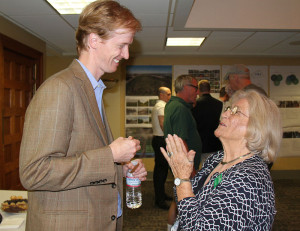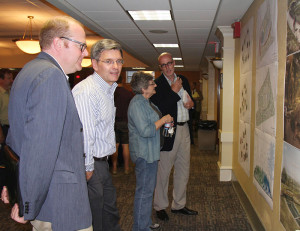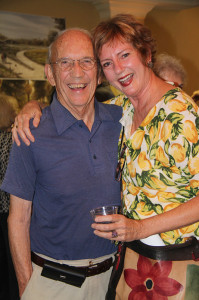By Martha Elson, Courier-Journal, September 8, 2014
Visitors to a proposed Waterfront Botanical Gardens at Frankfort Avenue and River Road would not only see ever-changing landscapes within the complex but also a new view of Louisville and the Big Four Bridge from an elevated walkway and overlook.

Other attractions could include a multi-story visitors center with restaurant, a children’s garden with giant seed pod structures that could become lanterns at night, art exhibits and a meadow area.
They’re all preliminary elements in a master plan that’s being developed by the Chicago and Atlanta-based design firm of Perkins + Will for Botanica, the local non-profit group that is planning the $35 million project.
Botanica unveiled the concepts recently at the Clifton Center, 3117 Payne St.
Even though renderings and other informational graphics were posted on the walls, plans are still evolving and could change, and the “big reveal” won’t occur until a Botanica members meeting in November, said Brian Voelker, Botanica’s board president.
Still, “we’re tremendously excited to see what it looks like,” he said of the plan. Voelker said he especially likes a concept for a water garden that would use plants to clean soiled, “gray” water.

The 23-acre site was once the Ohio Street landfill, which was closed by the city in the 1960s. The gardens would be built in phases, with the initial phase costing about $10 million, Voelker said. Fundraising would begin in earnest once the master plan is finalized.
More input and feedback were sought at the meeting, after Alexander “Zan” Stewart, a Louisville native with Perkins + Will, showed a PowerPoint presentation that included a dramatic aerial photo of the Frankfort/River Road site taken by a drone.
“We really want to push the boundaries with a facility that is lush, natural, bright and sunny,” Stewart said. The aim is to mend the “scar of a landfill” and turn the steep site into a singular attraction that will capitalize on its Louisville setting, he said. Matthew Kuhl, another Louisville native, also is a member of the planning team.
The mission is to create a place of “extraordinary beauty” that would “engage, enlighten and inspire people” from 4 to 90 years old — and keep them coming back, Stewart said.
There potentially could be tunnels and bridges that would entertain children and be a place where they could “get their hands dirty,” he said.
Work on the master plan began in May and is expected to be essentially completed this month, though there would be three more design phases afterward, Stewart said.

Local botanist Pat Haragan led an effort starting in the spring to survey and catalog the species growing at the “weedy” site. She said at the meeting that she found 57 native species and 74 non-native species. Among her finds was the rough marsh elder plant, which was a food source for Native Americans, she said.
Doris Downs, who lives in St. Matthews and participates in a charitable group called the Flower Buds that makes new arrangements from leftover flowers, attended the meeting. She said she likes the idea of a children’s garden and a museum/art area.
“The landscaping was particularly alluring,” she said.
Bob Hill, a Botanica board member and an owner of Hidden Hill Nursery in Utica, Ind., said at the meeting that the botanical gardens would be a boon to Indiana as well as Louisville, especially because people could now walk or ride bikes across the Big Four Bridge.
Botanica signed an agreement last year to take control of the site from the city. The deal outlines steps under which Botanica will take title, including completion of the master plan and raising $2 million as seed money. In addition to the $35 million to pay for the development, an endowment of $5 million to $8 million needs to be raised to sustain the operation, said Mike Kimmel, the board vice-president.
Joan Wipperson, who lives in the Wolf Pen Road area and is a member of the Jeffcoe Garden Club, said her club hopes to hold flower shows at the building. She said Louisville should have a botanical gardens: “It’s one of the few cities our size that doesn’t. We want to support it.”

